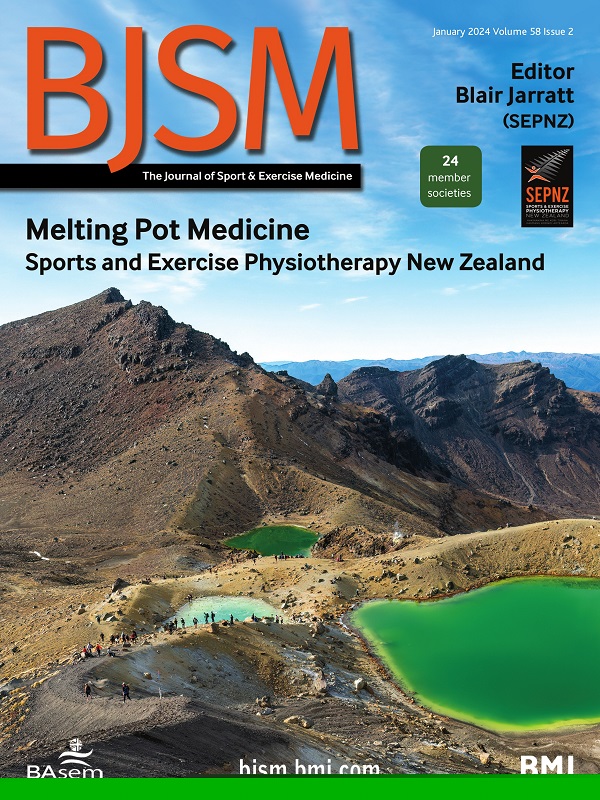质疑交战规则:对前交叉韧带重建后使用肢体对称指数安全恢复运动的批判性分析
IF 11.6
1区 医学
Q1 SPORT SCIENCES
引用次数: 0
摘要
目的评价股四头肌和腘绳肌力量的肢体对称指数(LSI)与前交叉韧带重建(ACL-R)后安全重返运动(RTS)的相关性,并结合跳跃试验,作为恢复的代表,与对称偏差(LSI 100%)的相关性。方法选取损伤前Tegner活动水平≥6的15 ~ 30岁运动员为研究对象。数据提取自一个康复专用注册表,项目ACL(哥德堡,瑞典),在每个运动员进行RTS时或之后。本研究的结果是安全的RTS - 2年内未发生第二次ACL损伤,通过使用LSI以五种不同的方式解决,测试结果包括在RTS时间或之后的五次肌肉功能测试。以安全RTS作为因变量进行Logistic回归分析,并给出or和95% ci。结果共纳入233名运动员,其中女性占51.1%。力量和跳跃测试的最佳区分截断值显示,具有安全RTS和未具有安全RTS的运动员之间的区分能力不显著差(Youden J 0.09-0.24,曲线下面积0.50-0.59)。与未达到安全RTS临界值的运动员相比,LSI≥80%或≥85%的运动员发生安全RTS的几率显著降低(or =0.32 (95% CI 0.12至0.87)和or =0.39 (95% CI 0.18至0.84)。LSI增加1%或偏离100%对称性对安全RTS没有影响。结论通过肌肉功能测试来确定ACL- r后的安全RTS,即2年内未发生第二次ACL损伤的RTS,不能区分具有安全RTS的运动员和未具有安全RTS的运动员,无论LSI是作为截断、递增还是偏离对称。因此,临床医生不单单依靠LSI来清除运动员的RTS具有临床重要性。如有合理要求,可提供资料。由于隐私原因和道德声明,可应要求获取数据。本文章由计算机程序翻译,如有差异,请以英文原文为准。
Questioning the rules of engagement: a critical analysis of the use of limb symmetry index for safe return to sport after anterior cruciate ligament reconstruction
Objective To evaluate the association between limb symmetry index (LSI) in quadriceps and hamstrings strength together with hop tests, as a proxy of recovery, and the deviation from being symmetrical (LSI 100%), with a safe return to sport (RTS) after anterior cruciate ligament reconstruction (ACL-R). Methods Athletes between 15 and 30 years old with a preinjury Tegner activity level ≥6 were eligible for inclusion. Data were extracted from a rehabilitation-specific registry, Project ACL (Gothenburg, Sweden) at the time of or after RTS for each athlete. The outcome of interest in this study was a safe RTS—not suffering a second ACL injury within 2 years from RTS—addressed by using the LSI in five different ways with results from the test battery which include five tests of muscle function at or after the time of RTS. Logistic regression analyses were performed with safe RTS as a dependent variable and presented with ORs and 95% CIs. Results In total, 233 athletes (51.1% women) were included. The best-differentiating cut-offs for strength and hop tests showed non-significantly poor discriminatory ability between athletes who had a safe RTS and those who did not (Youden J 0.09–0.24 and area under the curve 0.50–0.59). Athletes who had ≥80% or ≥85% LSI had significantly lower odds of safe RTS compared with athletes who did not meet the cut-offs of safe RTS (OR=0.32 (95% CI 0.12 to 0.87) and OR=0.39 (95% CI 0.18 to 0.84), respectively). There was no effect of a 1% increase in LSI or deviation from 100% symmetry on safe RTS. Conclusion The use of LSI from tests of muscle function to determine safe RTS after ACL-R, that is, RTS without sustaining a second ACL injury within 2 years, cannot differentiate between athletes who had a safe RTS and those who did not, regardless of whether LSI was used as cut-offs, incremental or as deviation from symmetry. Thus, it is of clinical importance that clinicians do not solely rely on the LSI to clear athletes for RTS. Data are available on reasonable request. Data can be obtained on request due to privacy reasons and ethical statements.
求助全文
通过发布文献求助,成功后即可免费获取论文全文。
去求助
来源期刊
CiteScore
27.10
自引率
4.90%
发文量
217
审稿时长
3-8 weeks
期刊介绍:
The British Journal of Sports Medicine (BJSM) is a dynamic platform that presents groundbreaking research, thought-provoking reviews, and meaningful discussions on sport and exercise medicine. Our focus encompasses various clinically-relevant aspects such as physiotherapy, physical therapy, and rehabilitation. With an aim to foster innovation, education, and knowledge translation, we strive to bridge the gap between research and practical implementation in the field. Our multi-media approach, including web, print, video, and audio resources, along with our active presence on social media, connects a global community of healthcare professionals dedicated to treating active individuals.

 求助内容:
求助内容: 应助结果提醒方式:
应助结果提醒方式:


